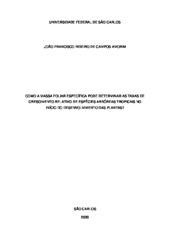| dc.contributor.author | Amorim, João Francisco Ribeiro de Campos | |
| dc.date.accessioned | 2021-01-13T21:03:31Z | |
| dc.date.available | 2021-01-13T21:03:31Z | |
| dc.date.issued | 2021-01-12 | |
| dc.identifier.citation | AMORIM, João Francisco Ribeiro de Campos. Como a massa foliar específica pode determinar as taxas de crescimento relativo de espécies arbóreas tropicais no início do desenvolvimento das plantas?. 2021. Trabalho de Conclusão de Curso (Graduação em Gestão e Análise Ambiental) – Universidade Federal de São Carlos, São Carlos, 2021. Disponível em: https://repositorio.ufscar.br/handle/ufscar/13686. | * |
| dc.identifier.uri | https://repositorio.ufscar.br/handle/ufscar/13686 | |
| dc.description.abstract | Changes in land use through deforestation and forest degradation have resulted in great losses of biodiversity and ecosystem functions and services and recognition of the importance of forests has resulted in several actions for their restoration. Plant growth rates can be strongly related to the leaf area per dry mass unit (SLA) which reflects the photosynthetic capacity per leaf area unit. However, other crown attributes such as the projection area of the crown, the surface area of the crown and the number of leaves can contribute to the photosynthetic capacity of the plants and thus influence the growth rates. The objective of this study is to evaluate the influence of SLA and the attributes of the crown on the growth rates of the plants of eleven tropical tree species reintroduced in a degraded area. For each species, five individuals were marked for growth monitoring over a year, measuring the total number of leaves, three crown measures (height, largest diameter of the crown and the orthogonal diameter to the largest diameter). From each individual, two expanded leaves were collected to estimate the SLA. The leaves were photographed, to estimate the leaf area, and weighed (fresh mass), and then left in the greenhouse, to estimate the dry mass. SLA is the ratio of the leaf area to the dry mass. Five models were evaluated to determine the influence of crown attributes on the relationship between SLA and the growth rates in height of the plants: (I) - considering only the SLA; (II) - AMF × SLA; (III) - CPA × SLA; (IV) - CSA × SLA and (V) - SM. The choice of models was made according to the corrected Akaike criterion. Model III, the relationship between RGR and SLA x CPA, was the one that best explained the growth rate of individuals, followed by model IV, showing that the larger the leaf area, the crown projection area and the crown surface area, the higher the relative growth rate of the species. In addition, model V showed that large seed plants produce small CPA and CSA, compromising the RGR. | por |
| dc.description.sponsorship | Não recebi financiamento | por |
| dc.language.iso | por | por |
| dc.publisher | Universidade Federal de São Carlos | por |
| dc.rights | Attribution-NonCommercial-NoDerivs 3.0 Brazil | * |
| dc.rights.uri | http://creativecommons.org/licenses/by-nc-nd/3.0/br/ | * |
| dc.subject | Biomonitoramento, áreas degradadas, atributos da copa de espécies arbóreas. | por |
| dc.title | Como a massa foliar específica pode determinar as taxas de crescimento relativo de espécies arbóreas tropicais no início do desenvolvimento das plantas? | por |
| dc.title.alternative | How can specific leaf mass determine the relative growth rates of tropical tree species at the beginning of plant development? | por |
| dc.type | TCC | por |
| dc.contributor.advisor1 | Souza, Andréa Lúcia Teixeira de | |
| dc.contributor.advisor1Lattes | http://lattes.cnpq.br/5216112068627151 | por |
| dc.description.resumo | As mudanças no uso do solo através de desmatamento e a degradação de florestas tem resultado em grandes perdas de biodiversidade e das funções e serviços ecossistêmicos e reconhecimento da importância de florestas resultou em diversas ações para a sua restauração. As taxas de crescimento das plantas pode ser fortemente relacionada com a área foliar por unidade de massa seca (AFE) que reflete a capacidade fotossintética por unidade de área foliar. No entanto, outros atributos como a área superficial da copa podem contribuir para a capacidade fotossintética das plantas. O objetivo deste estudo é avaliar a influência da AFE (área foliar específica) e os atributos da copa nas taxas de crescimento das plantas de onze espécies arbóreas tropicais reintroduzidas numa área degradada. Para cada espécie, cinco indivíduos foram marcados para o monitoramento do crescimento ao longo de um ano, medindo o número total de folhas, três medidas de copa (altura, maior diâmetro da copa e o diâmetro ortogonal ao maior diâmetro). De cada indivíduo, duas folhas expandidas foram coletadas para a estimativa da AFE. As folhas foram fotografadas, para a estimativa da área foliar, e pesadas (massa fresca), e então deixadas em estufa, para estimativa da massa seca. A AFE é a razão entre a área foliar e a massa seca. Cinco modelos foram avaliados para determinar a influência dos atributos de copa na relação entre AFE e as taxas de crescimento em altura das plantas: {I} - considerando apenas a AFE; {II} – FMA (fração da massa aérea) multiplicada pela AFE; {III} - APC (área de projeção da copa) multiplicada pela AFE; {IV} - ASC (área superficial da copa) multiplicada pela AFE e {V} – MS (massa da semente). A seleção dos modelos foi feita segundo o critério de Akaike corrigido. O modelo III, relação entre a TCR e a AFE x APC, foi o que melhor explicou a taxa de crescimento dos indivíduos, seguido pelo modelo IV, mostrando que quanto maior é a área foliar, a área de projeção da copa e a área superficial da mesma, maior é a taxa de crescimento relativo das espécies. Além disso, o modelo V mostrou que plantas de sementes grandes produzem APC e ASC pequenas, comprometendo a TCR. | por |
| dc.publisher.initials | UFSCar | por |
| dc.subject.cnpq | CIENCIAS BIOLOGICAS::ECOLOGIA | por |
| dc.publisher.address | Câmpus São Carlos | por |
| dc.contributor.authorlattes | http://lattes.cnpq.br/7610565223969829 | por |
| dc.publisher.course | Gestão e Análise Ambiental - GAAm | por |

